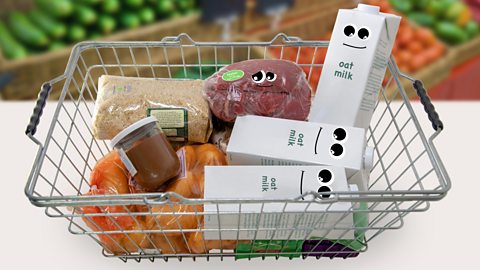What does sustainable food mean?
All food makes a journey from source to consumer. This journey is calculated in food milesThe distance that food has travelled in order to reach our plates..
Food with more food miles requires more energy and is less sustainable. Food with fewer food miles requires less energy and is more sustainable.
In this article you can learn:
- what food miles are
- the difference between processed and fresh food
- how food production can impact the environment
- how we can make more sustainable food choices
This resource is suitable for Health and Wellbeing for primary school learners.
Video - Food miles
In this video, the Great Spoon explains what food miles are and why local food is often a more sustainable option.
Find out how our food choices can have an impact on the environment.
PEAR Do you know what mate? I just got a bit bored hanging around. So it’s great to come somewhere different - have a change of scene. You know?
CUCUMBER Aye. It’s good to travel. Where is it you’re from?
PEAR Outside. There. In the garden.
CUCUMBER Ah! You’re a local. I’m pretty local too. Well, Scottish anyway. D’you wanna see my tattoo?
PEAR Not really, that’s not a tattoo that’s a sticker, pal.
CUCUMBER Oh…
PEAR Aye. It says “Product of Scotland”.
CUCUMBER Scottish and proud.
PEAR Oh.
CUCUMBER Oh!
THE GREAT SPOON That sticker tells shoppers where you came from. You come from Scotland so you haven’t had to travel far. That’s better for the environment. And it means you’re fresher too.
PEAR I don’t have a sticker but then I literally came from the human’s garden.
THE GREAT SPOON Some foods can be produced easily in Scotland. Some can only grow in greenhouses that are warmer. You grew in a greenhouse in Inverclyde and were driven fifty miles to the supermarket. That chocolate bar travelled here too, but from far, far away.
CUCUMBER I’ve actually never seen a chocolate bar tree! Where do they grow?
CHOCOLATE BAR There’s no such thing as a chocolate bar tree! I come all the way from Switzerland – that’s where I was made.
CUCUMBER Oh…
CHOCOLATE BAR Milk from Europe was mixed with sugar from Brazil and my main ingredient, cocoa beans from Ghana. That’s in Africa. I’ve properly travelled.
THE GREAT SPOON Cocoa beans need humid weather - warm and wet. That’s why they are grown in parts of Africa. Like so many other foods, cocoa beans get from where they grew to where they were processed using many methods of transport: a truck to the port then a boat to Europe then another truck. The journey can take weeks!
PEAR And now you’re in Scotland! You’re a very well travelled bar of chocolate!
CHOCOLATE BAR 6,400 miles in total.
CUCUMBER That’s a lot of food miles.
PEAR Food miles? What are food miles?
THE GREAT SPOON Travelling by boat, plane and truck all use up energy. And that releases greenhouse gases that add to global warming.
PEAR And to think, I grew just out there in the garden not even 10 metres away!
THE GREAT SPOON The fewer food miles the better. Local foods like you add less to global warming. Cutting down on foods with lots of food miles can help the environment.
PEAR People can still enjoy them, just not so often.
CUCUMBER Here’s an idea. We could plant chocolate bar trees and grow our own chocolate bars in the garden!
PEAR Pal, have you no been listening to anything anyone’s been saying?
What are food miles?
Food miles measure the distance a food has travelled to get to your plate using transport that produces carbon emissionsThe release of carbon into the Earth’s atmosphere. This contributes to climate change.. Some food travels from the farm it is grown on to a shop to be sold. Other foods travel to a factory first and then to a supermarket or shop.
Food that is grown and produced locally is a more sustainableUsing something in a way that does not destroy it completely. option for our environment.
We have access to food products from all over the world. For example, cheese from Europe and bananas from South America. Almost anything can be import To bring in products or goods from another country..
Are processed foods sustainable?
Processed foods will contain a list of different ingredients. Each ingredient will already have travelled some distance before they are all mixed together.
For example, a prepackaged fruit salad from the supermarket could contain strawberries from Scotland, pineapple from Costa Rica and grapes from Egypt.
- Each of these foods created food milesThe distance that food has travelled in order to reach our plates. on their way to the factory where they were prepared and packed.
- They then gained more food miles on their journey to the supermarket.
- Finally, further food miles would have been added if a customer travelled to and from the supermarket by car or bus.
Learn more about food processing: What is food processing?
Are fresh foods more sustainable?
Fresh foods gain miles when they are transported from where they are grown to where they will be bought by the consumer.
For example, pears from Argentina will have travelled over 7,000 miles to reach the UK. All the energy needed to transport the pears from Argentina creates a carbon footprintThe amount of greenhouse gases produced..
Food and the environment
We need energy to grow, produce and transport food. Producing some food uses more energy than others. Lots of our energy comes from fossil fuelsFuels that come from the Earth. Fossil fuels are all old life forms that have decomposed and been compressed over a long period of time under ground or under the sea. Coal, oil and gas are fossil fuels. which all produce carbon emissionsThe release of carbon into the Earth’s atmosphere. This contributes to climate change..
What are carbon emissions?
Carbon emissions are gases such as carbon dioxide, methane and nitrous oxide. These are released into the Earth’s atmosphere when we burn fossil fuels to release energy. Carbon emissions are a cause of global warmingThe increase in the Earth's average temperature due to the greenhouse gases released in to the environment when people burn fossil fuels. and some cause pollution.
What is global warming?
Global warming is part of climate change. It means the increase in overall temperature of the Earth’s atmosphere. Carbon emissions acts like a greenhouse surrounding our Earth. They prevent heat escaping from the Earth’s atmosphere and this makes the planet warmer.
How to reduce food miles
Our food choices have an impact on our environment.
By looking out for stickers and packaging that tells us where our food has come from, we can try to reduce our food miles by buying local, sustainable food.
We can also eat less of foods that it takes a lot of energy to produce.
Examples of food that use a lot of energy
- meat and dairy
- food that is grown in heated greenhouses
- heavily processed foods
Sustainable food vocabulary
Here is a list of key words about sustainable food and food miles:
- sustainable - if a food source is sustainable it means it can continue to be used without running out. For example, if we always fish in the same part of the sea and never allow the fish population to breed and grow again the fish supply in that area will eventually run out.
- local - a place close by, somewhere near to where you live. A shop in your town would be your local shop as opposed to a shop you had to travel to.
- imported foods - foods that have been brought into a country from another country to be sold.
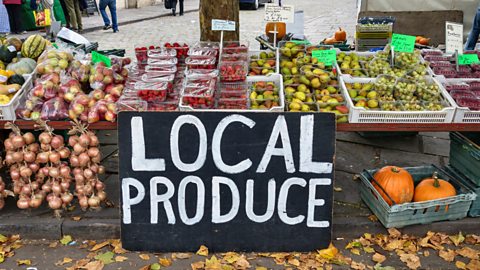
Image caption, Local food
Fruit and vegetables that were grown near your home would be considered local. This is better for the environment because less energy has been used to get the food to you.
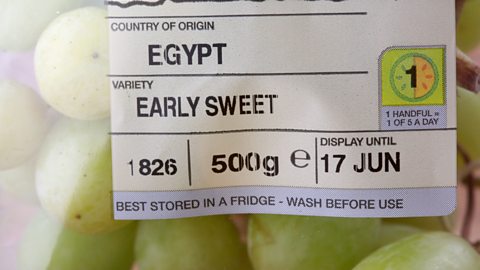
Image caption, Food miles
Food miles are the distance food has travelled to get to your plate. You can check where your food is from by looking for a 'country of origin' sticker. These grapes are from Egypt.
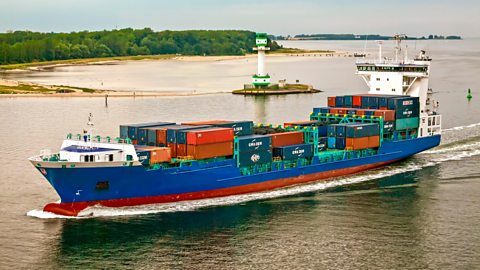
Image caption, Transport
Transporting food around the world on lorries, boats and planes uses up a lot of energy. Using fossil fuels (coal and oil) to provide energy releases harmful gases such as carbon dioxide into the Earth’s atmosphere.
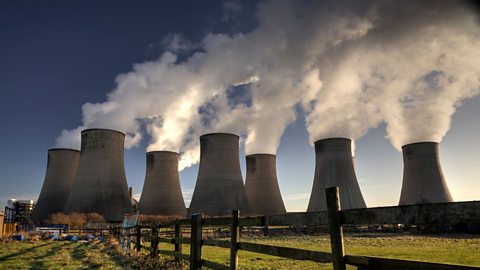
Image caption, Fossil fuels
We burn fossil fuels, like coal, to provide the energy that helps grow, produce and transport food around the world. This creates harmful gases called carbon emissions.
1 of 4
Test your knowledge
Quiz - Sustainable food
Try this short true-or-false quiz to test your knowledge on sustainable food production.
Challenge - Investigate food miles
Think about your favourite foods. Investigate where each of the ingredients came from and calculate their food miles.
Easy recipes for kids
Try using up ingredients in your kitchen with some tasty recipes. Remember to get some help from a grown up.

Climate change food calculator. activityClimate change food calculator
Use this climate change food calculator to discover more about food miles and carbon emissions.
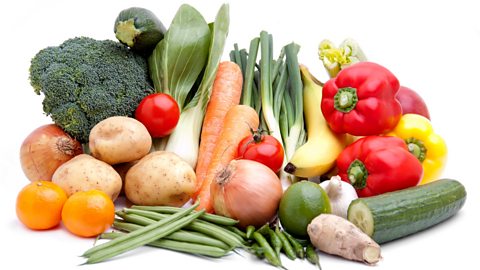
2nd level Sustainability. list2nd level Sustainability
Find out more our sustainability with 2nd level Science on Bitesize.

More on Food and health
Find out more by working through a topic
- count1 of 10

- count2 of 10
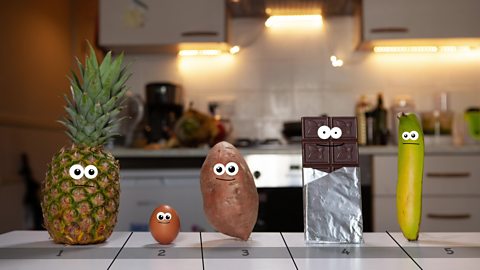
- count3 of 10
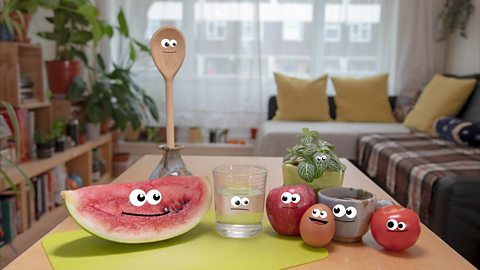
- count4 of 10
